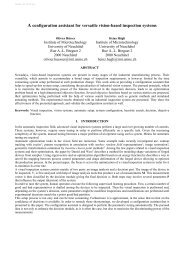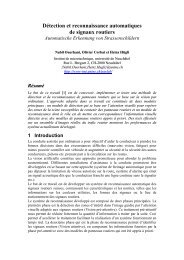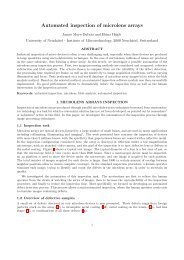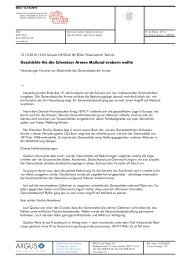Continuous Wavelet Transform on the Hyperboloid - Université de ...
Continuous Wavelet Transform on the Hyperboloid - Université de ...
Continuous Wavelet Transform on the Hyperboloid - Université de ...
You also want an ePaper? Increase the reach of your titles
YUMPU automatically turns print PDFs into web optimized ePapers that Google loves.
4<br />
p=0.5<br />
4<br />
p=1<br />
3.5<br />
3.5<br />
3<br />
3<br />
2.5<br />
2.5<br />
2<br />
2<br />
1.5<br />
1.5<br />
1<br />
1<br />
0.5<br />
0.5<br />
0<br />
−4 −3 −2 −1 0 1 2 3 4<br />
0<br />
−4 −3 −2 −1 0 1 2 3 4<br />
Fig. 4. Cross-secti<strong>on</strong> of c<strong>on</strong>ic projecti<strong>on</strong>s for different values of parameter p.<br />
x<br />
0<br />
H 2 +<br />
a<br />
P<br />
P a<br />
N<br />
P<br />
P<br />
x<br />
1<br />
C<br />
0<br />
P<br />
P<br />
Pa<br />
P<br />
0<br />
x<br />
2<br />
Fig. 5. Acti<strong>on</strong> of a dilati<strong>on</strong> a <strong>on</strong> <strong>the</strong> hyperboloid H 2 + by c<strong>on</strong>ic projecti<strong>on</strong> with<br />
parameter p =1.<br />
The acti<strong>on</strong> of dilati<strong>on</strong> by c<strong>on</strong>ic projecti<strong>on</strong> is given by<br />
sinh pχ a = a sinh pχ (21)<br />
The particular case p = 1 is <strong>de</strong>picted in Figure 5. The dilated point x a ∈ H+<br />
2<br />
is<br />
x a =(coshχ a , sinh χ a cos ϕ, sinh χ a sin ϕ), (22)<br />
with polar coordinates θ a =(χ a ,ϕ). The behaviour of dist(x N , x a ), with x N<br />
being <strong>the</strong> North Pole, is shown in Figure 6 in <strong>the</strong> case p =0.1, p =0.5 and<br />
p = 1. We can see that this is an increasing functi<strong>on</strong> with respect to <strong>the</strong><br />
dilati<strong>on</strong> a.<br />
It is also interesting to compute <strong>the</strong> acti<strong>on</strong> of dilati<strong>on</strong>s in <strong>the</strong> boun<strong>de</strong>d versi<strong>on</strong><br />
of H+ 2 . The latter is obtained by applying <strong>the</strong> stereographic projecti<strong>on</strong> from<br />
<strong>the</strong> South Pole of H 2 and it maps <strong>the</strong> upper sheet H+ 2 <strong>on</strong>to <strong>the</strong> open unit disc<br />
9
















